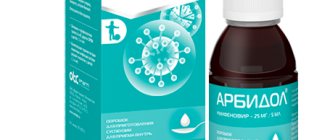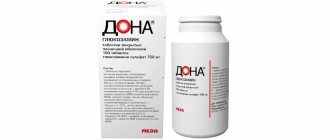Augmentin EC 600mg+42.9mg/5ml 23.13g (100ml) powder for suspension for oral administration
Composition and release form Augmentin EC 600mg+42.9mg/5ml 23.13g (100ml) powder for the preparation of suspension for oral administration
Active ingredients: amoxicillin trihydrate (in terms of amoxicillin) 697.65 (600), potassium clavulanate (in terms of clavulanic acid) 52.31 (42.9).
Excipients: xanthan gum 3.26, aspartame 13.6, silicon dioxide 153.29, colloidal silicon dioxide 38.08, sodium carmellose 32.64, strawberry flavor 28.29.
Powder for the preparation of suspension for oral administration 23.13 g.
Description of the dosage form
Powder: almost white with a characteristic strawberry smell. When diluted with water, an almost white suspension is formed.
Directions for use and doses
Dosing of the drug Augmentin EC is carried out in accordance with the age of the child, the dose is calculated in mg/kg/day or in ml of the finished suspension.
Dosage calculations are based on amoxicillin and clavulanic acid, except in cases where dosing is carried out for each component separately. To minimize potential adverse events from the gastrointestinal tract and optimize absorption, the drug should be taken orally at the beginning of a meal. Treatment should not be continued for more than 14 days without reviewing the clinical situation. If necessary, it is possible to carry out stepwise therapy (at the beginning - intravenous administration of the drug Augmentin (powder for preparing a solution for intravenous administration) followed by transition to oral administration).
Children Augmentin EC is recommended for children aged 3 months and older. There is no experience with the use of Augmentin EC in children under 3 months. The recommended daily dose is 90 mg of amoxicillin and 6.4 mg of clavulanic acid per 1 kg of body weight, divided into 2 doses every 12 hours, for 10 days. For patients weighing more than 40 kg, other dosage forms of Augmentin are recommended. In terms of the content of clavulanic acid, Augmentin EC differs from other suspensions containing amoxicillin and clavulanic acid. Augmentin EC contains 600 mg of amoxicillin and 42.9 mg of clavulanic acid in 5 ml of reconstituted suspension, while preparations containing 200 and 400 mg of amoxicillin in 5 ml of suspension contain 28.5 and 57 mg of clavulanic acid in 5 ml, respectively. suspensions. Preparations in the form of suspensions with a dosage of 200 mg of amoxicillin in 5 ml, 400 mg of amoxicillin in 5 ml and the drug Augmentin EC are not interchangeable.
Special groups of patients.
Patients with impaired renal function. No dosage adjustment is required when creatinine Cl is 30 ml/min. The drug is not recommended for use when creatinine Cl <30 ml/min.
Method of preparing the suspension The suspension is prepared immediately before the first use. Add approximately 2/3 of the volume of boiled water, cooled to room temperature, indicated in the table below to the powder, then close the bottle with a lid and shake until the powder is completely diluted, let the bottle stand for 5 minutes to ensure complete dilution. Then add water up to the mark on the bottle and shake the bottle again. The bottle should be shaken well before each use. To accurately dose the drug, use a measuring spoon, which must be rinsed well with water after each use. After dilution, the suspension should be stored for no more than 10 days in the refrigerator, but not frozen.
Indications for use Augmentin EC 600mg+42.9mg/5ml 23.13g (100ml) powder for the preparation of suspension for oral administration
- Upper respiratory tract infections: recurrent or persistent acute otitis media caused by Streptococcus pneumoniae (minimal inhibitory concentration
- Tonsillo-pharyngitis and sinusitis, usually caused by Streptococcus pneumoniae, Haemophilus influenzae1, Moraxella catarrhalis1 and Streptococcus pyogenes;
- lower respiratory tract infections: lobar pneumonia and bronchopneumonia caused by Streptococcus pneumoniae, Haemophilus influenzae1, Moraxella catarrhalis1;
- infections of the skin and soft tissues, usually caused by Staphylococcus aureus1 and Streptococcus pyogenes.
Contraindications
- History of hypersensitivity to amoxicillin, clavulanic acid, other components of the drug, beta-lactam antibiotics (for example, penicillins, cephalosporins);
- history of previous episodes of jaundice or impaired liver function when using a combination of amoxicillin and clavulanic acid;
- children up to 3 months;
- renal dysfunction (Clcreatinine
- phenylketonuria.
With caution: Augmentin EC should be used with caution in patients with impaired liver function.
Effect on the body
Broad spectrum antibacterial effect (bactericidal).
Application Augmentin EC 600mg+42.9mg/5ml 23.13g (100ml) powder for the preparation of suspension for oral administration during pregnancy and breastfeeding
In animal reproductive studies, oral and parenteral administration of Augmentin did not cause teratogenic effects. In a single study in women with premature rupture of membranes, it was found that prophylactic therapy with the drug may be associated with an increased risk of developing necrotizing enterocolitis in newborns. Like all medicinal products, Augmentin EC is not recommended for use during pregnancy, unless the expected benefit to the mother outweighs the potential risk to the fetus. Augmentin EC can be used during breastfeeding. With the exception of the possibility of diarrhea or oral candidiasis associated with the passage of trace amounts of the active ingredients of this drug into breast milk, no other adverse effects have been observed in breastfed infants. If adverse effects occur in breastfed infants, breastfeeding should be discontinued.
Do not use in children under 3 months.
Overdose
Gastrointestinal disorders and disturbances in water and electrolyte balance may occur. Symptoms: gastrointestinal symptoms and water and electrolyte imbalance may be observed. Amoxicillin crystalluria has been described, in some cases leading to the development of renal failure. Convulsions may occur in patients with impaired renal function, as well as in those receiving high doses of the drug. Treatment: symptoms from the gastrointestinal tract - symptomatic therapy, paying special attention to the normalization of water and electrolyte balance. Amoxicillin and clavulanic acid can be removed from the bloodstream by hemodialysis. The results of a prospective study that was conducted in 51 children at a poison control center showed that amoxicillin administered at a dose of less than 250 mg/kg did not lead to significant clinical symptoms and did not require gastric lavage.
Side effects Augmentin EC 600mg+42.9mg/5ml 23.13g (100ml) powder for suspension for oral administration
The adverse events presented below are listed depending on the anatomical and physiological classification and frequency of occurrence. The frequency of occurrence is determined as follows: very often - 1/10; often - 1/100 and <1/10; Uncommon - 1/1000 and <1/100; rarely - 1/10000 and <1/1000; very rare - <1/10000, including isolated cases. Frequency categories were formed based on clinical studies of the drug and post-registration surveillance. Frequency of occurrence of adverse events Infectious and parasitic diseases: often - candidiasis of the skin and mucous membranes.
Disorders of the blood and lymphatic system: rarely - reversible leukopenia (including neutropenia) and reversible thrombocytopenia; very rarely - reversible agranulocytosis and reversible hemolytic anemia, prolongation of PT and bleeding time, anemia, eosinophilia, thrombocytosis.
Immune system disorders: very rarely - angioedema, anaphylactic reactions, a syndrome similar to serum sickness, allergic vasculitis.
Nervous system disorders: infrequently - dizziness, headache; very rarely - reversible hyperactivity, convulsions (convulsions can be observed in patients with impaired renal function, as well as in those receiving high doses of the drug); insomnia, agitation, anxiety, behavior changes.
Gastrointestinal disorders: often - diarrhea, nausea, vomiting. Nausea is more common with high oral doses. If gastrointestinal disorders are confirmed, they can be eliminated if the drug is taken at the beginning of a meal; infrequently - digestive disorders; very rarely - antibiotic-associated colitis, induced by antibiotics (including pseudomembranous colitis and hemorrhagic colitis), black “hairy” tongue. Children very rarely experienced discoloration of the surface layer of tooth enamel. Oral care helps prevent discoloration of tooth enamel by simply brushing your teeth.
Disorders of the liver and biliary tract: uncommon - moderate increase in AST and/or ALT activity. This phenomenon has been observed in patients receiving beta-lactam antibiotic therapy, but its clinical significance is unknown; very rarely - hepatitis and cholestatic jaundice (noted with concomitant therapy with other penicillins and cephalosporins), increased concentrations of bilirubin and alkaline phosphatase. Adverse liver events have been observed primarily in men and elderly patients and may be associated with long-term therapy. These adverse events are very rarely observed in children. The listed signs and symptoms usually occur during or immediately after completion of therapy, but in some cases they may not appear for several weeks after completion of therapy. Adverse effects are usually reversible. Adverse liver events can be severe, and deaths have been reported in extremely rare cases. In almost all cases, these were persons with serious comorbidities or persons receiving concomitantly potentially hepatotoxic drugs.
Disorders of the skin and subcutaneous tissues: infrequently - rash, itching, urticaria; rarely - erythema multiforme; very rarely - Stevens-Johnson syndrome, toxic epidermal necrolysis, bullous exfoliative dermatitis, acute generalized exanthematous pustulosis. If allergic skin reactions occur, treatment with Augmentin EC should be discontinued.
Renal and urinary tract disorders: very rarely - interstitial nephritis, crystalluria, hematuria.
Drug interactions
The simultaneous use of Augmentin EC and probenecid is not recommended. Probenecid reduces the tubular secretion of amoxicillin, and therefore the simultaneous use of Augmentin EC and probenecid may lead to an increase and persistence in the blood concentration of amoxicillin, but not clavulanic acid. Concomitant use of allopurinol and amoxicillin may increase the risk of allergic skin reactions. Currently, there is no data in the literature on the simultaneous use of a combination of amoxicillin with clavulanic acid and allopurinol. Penicillins can slow down the elimination of methotrexate from the body by inhibiting its tubular secretion, so the simultaneous use of Augmentin EC and methotrexate may increase the toxicity of methotrexate. Like other antibacterial drugs, Augmentin EC can affect the intestinal microflora, leading to a decrease in the absorption of estrogens from the gastrointestinal tract and a decrease in the effectiveness of combined oral contraceptives. The literature describes rare cases of increased INR in patients with the combined use of acenocoumarol or warfarin and amoxicillin. If it is necessary to simultaneously prescribe Augmentin EC with anticoagulants, PT or INR should be carefully monitored when prescribing or discontinuing Augmentin EC; dose adjustment of anticoagulants for oral administration may be required.
Instructions for use AUGMENTIN® ES
Before starting treatment with amoxicillin/clavulanic acid, it is necessary to obtain a detailed history regarding previous hypersensitivity reactions to penicillins, cephalosporins or other beta-lactam antibiotics (see sections “Contraindications” and “Side effects”).
Serious, sometimes fatal, hypersensitivity reactions (anaphylactoid reactions) to penicillins have been described. The risk of such reactions is highest in patients with a history of hypersensitivity reactions to penicillins and in individuals with atopy. If an allergic reaction occurs, treatment with Augmentin® EC should be discontinued and alternative therapy initiated.
If the infection is confirmed to be due to amoxicillin-susceptible organisms, a switch from amoxicillin/clavulanic acid therapy to amoxicillin therapy should be considered in accordance with official guidelines.
In patients with impaired renal function or when taking the drug in high doses, seizures may occur (see section "Side effects").
The use of amoxicillin/clavulanic acid is not recommended for suspected infectious mononucleosis, since such patients experience a morbilliform rash after taking amoxicillin.
The combined use of allopurinol and amoxicillin increases the risk of allergic skin reactions.
Long-term treatment with the drug may lead to excessive proliferation of insensitive microorganisms.
The appearance of pustules on erythematous areas of the skin with fever at the beginning of treatment may be a symptom of acute generalized exanthematous pustulosis (see section “Side effects”). The occurrence of this adverse reaction requires discontinuation of the drug and is a contraindication to further use of amoxicillin.
The combination of amoxicillin/clavulanic acid should be used with caution in patients with signs of liver failure (see sections “Dosage regimen”, “Contraindications”, “Special instructions”).
Adverse liver events have been observed primarily in men and elderly patients and may be associated with long-term therapy. These adverse events are very rarely observed in children. Signs and symptoms of liver dysfunction usually occur during or immediately after completion of therapy, but in some cases may not appear until several weeks after completion of therapy. As a rule, they are reversible. Adverse effects from the liver can be severe, and in extremely rare cases there have been reports of death. In almost all cases, these were patients with serious comorbidities or patients simultaneously receiving potentially hepatotoxic drugs (see section "Side effects").
Antibiotic-associated colitis has been reported with virtually all antibacterial agents, including amoxicillin. This adverse reaction can vary in severity from mild to life-threatening (see section "Side effects"). Therefore, this diagnosis should be considered in patients who develop diarrhea during treatment or after administration of any antibiotics. If antibiotic-associated colitis occurs, the drug should be discontinued immediately. The patient should consult a doctor who will prescribe appropriate treatment. In such a situation, the use of drugs that inhibit peristalsis is contraindicated.
During long-term therapy with Augmentin® EC, it is recommended to periodically evaluate the function of the kidneys, liver and hematopoietic organs.
In patients receiving a combination of amoxicillin and clavulanic acid, prolongation of prothrombin time has been observed in rare cases. When co-prescribing a combination of amoxicillin and clavulanic acid with anticoagulants, appropriate monitoring should be carried out. To maintain the desired level of anticoagulants, dose adjustment may be required (see section “Drug Interactions” and “Side Effects”).
In patients with reduced diuresis, the development of crystalluria has been reported in very rare cases, mainly with parenteral use of the drug. When taking high doses of amoxicillin, it is recommended to drink enough fluids and maintain adequate diuresis to reduce the chance of amoxicillin crystal formation. In patients with urinary catheters, catheter patency should be checked regularly (see section "Overdose").
During treatment with amoxicillin, if tests for the presence of glucose in urine are necessary, enzymatic methods for determining glucose oxidase should be used due to the possibility of obtaining a false positive result when using non-enzymatic methods.
The presence of clavulanic acid in the drug may cause nonspecific binding of IgG and albumin to red blood cell membranes, which may lead to a false-positive Coombs test result.
Patients taking the amoxicillin/clavulanic acid combination may have a false-positive test result for Aspergillus infection using the Platelia Aspergillus EIA tests. There have been reports of cross-reactions between the Platelia Aspergillus EIA test and non-Aspergillus polysaccharides and polyfuranoses. Therefore, positive test results in patients taking the combination of amoxicillin/clavulanic acid should be interpreted with caution and confirmed by other diagnostic methods.
Augmentin® EC in powder form for oral suspension contains 2.72 mg of aspartame (E951) per ml of suspension, which is a source of phenylalanine, so the drug should be used with caution in patients with phenylketonuria.
Augmentin® EC contains maltodextrin (glucose), so the drug should not be prescribed to patients with glucose-galactose malabsorption.
Impact on the ability to drive vehicles and operate machinery
No special studies have been conducted. However, adverse reactions may occur (allergic reactions, dizziness, convulsions), which may affect the ability to drive vehicles and other mechanisms (see section “Side Effects”).


